54.3 Configuring the WebPublisher Application
The WebPublisher Application, which resides on the Web server, provides the WebPublisher user interface. As users perform actions in the WebPublisher client, the WebPublisher Application passes information between the Web browser and the WebAccess Agent.
Figure 54-5 WebPublisher Application
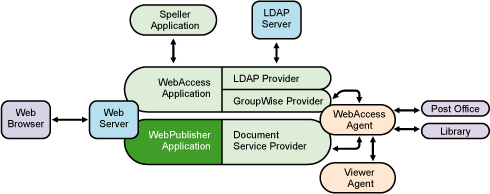
During installation, the WebPublisher Application is set up with a default configuration. However, you can use the information in the following sections to optimize the WebPublisher Application configuration:
54.3.1 Modifying the WebPublisher Application Environment Settings
Using ConsoleOne, you can modify the WebPublisher Application’s environment settings. The environment settings determine such things as the location where ConsoleOne stores the WebPublisher Application’s configuration file.
To modify the environment settings:
-
In ConsoleOne, right-click the WebPublisher Application object (GroupWiseWebPublisher), > click .
NOTE:The WebPublisher Application object is not available in the GroupWise View. To locate the WebPublisher Application object, you must use the Console View.
-
Click to display the Environment page.
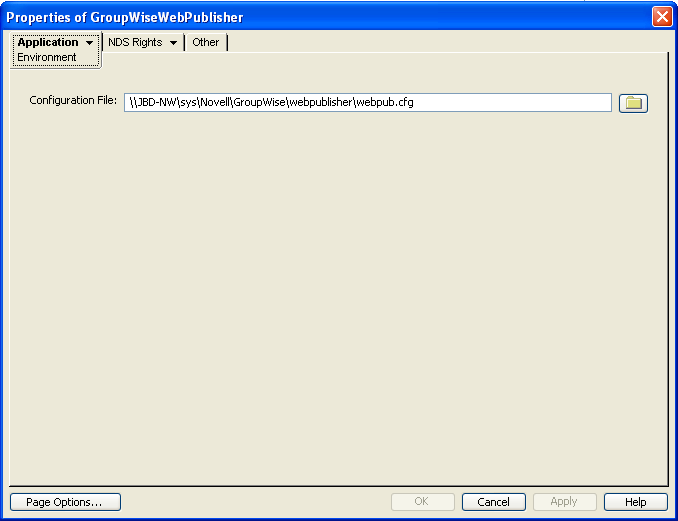
-
Modify any of the following fields:
Configuration File: The WebPublisher Application does not have access to Novell eDirectory or the GroupWise domain database. Therefore, ConsoleOne writes the application’s configuration information to the file specified in this field. By default, this is the webpub.cfg file located in the WebPublisher Application’s home directory, which varies by platform.
NetWare:
sys:\Novell\GroupWise\WebPublisher on the Web server
Linux:
Windows:
c:\Novell\GroupWise\WebPublisher on the Web server
In general, you should avoid changing the location of the file. If you do change the location of the file, you need to make sure to modify the webpub.cfg path in the Java servlet engine’s properties file. If you do not, the WebPublisher Application continues to look for its configuration information in the old location.
-
Click to save the changes.
54.3.2 Adding or Removing Service Providers
The WebPublisher Application receives requests from users and then passes the requests to the appropriate service provider. The service provider fills the requests and returns the required information to the WebPublisher Application. The WebPublisher Application merges the information into the appropriate template and displays it to the user.
To function properly, the WebPublisher Application must know which service providers are available. By default, WebPublisher includes one service provider, the GroupWise Document service provider (GroupWiseDocumentProvider). The GroupWise Document service provider communicates with the WebAccess Agent to fill WebPublisher requests.
The GroupWise Document service provider is installed and configured at the same time as the WebPublisher Application. You can disable the GroupWise Document service by removing the GroupWise Document service provider. If you create new service providers to expose additional services through GroupWise WebPublisher, you must define those service providers so that the WebPublisher Application knows about them.
To define service providers:
-
In ConsoleOne, right-click the WebPublisher Application object, then click .
-
Click to display the Services page.
The Provider List displays all service providers that the WebPublisher Application is configured to use.
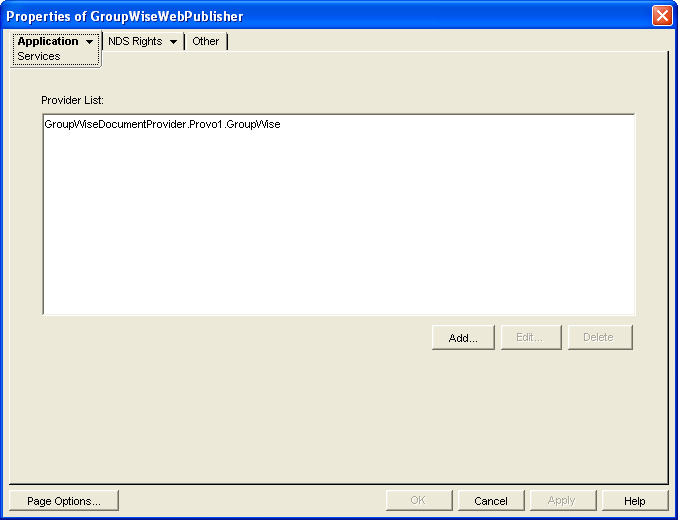
-
Choose from the following options:
Add: To add a service provider to the list, click , browse for and select the service provider’s object, then click .
Edit: To edit a service provider’s information, select the provider in the list, then click . For information about the modifications you can make, see Section 54.6, Configuring the GroupWise Document Service Provider.
Delete: To remove a service provider from the list, select the provider, then click .
-
Click to save the changes.
54.3.3 Modifying WebPublisher Application Template Settings
When the WebPublisher Application receives information from a service provider, it merges the information into the appropriate WebPublisher template before displaying the information to the user. Using ConsoleOne, you can modify the WebPublisher Application’s template settings. The template settings determine such things as the location of the templates, the maximum amount of server memory to use for caching the templates, and the default template language.
-
In ConsoleOne, right-click the WebPublisher Application object, then click .
-
Click to display the Templates page.
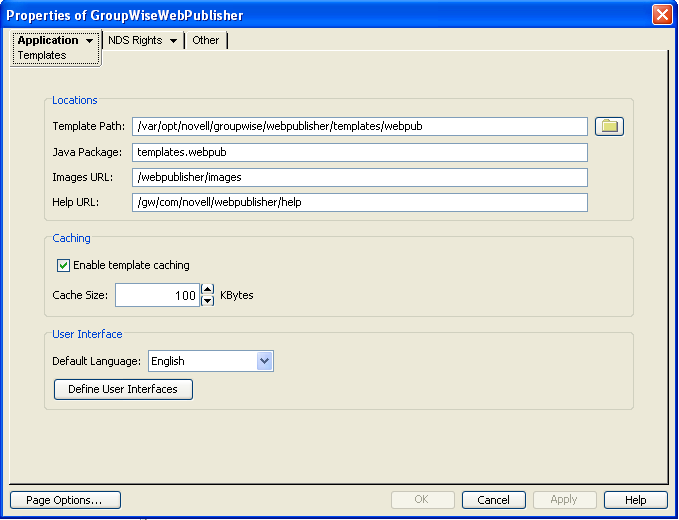
-
Modify any of the following fields:
Template Path: Select the location of the template base directory. The template base directory contains the subdirectories for each of the templates provided with GroupWise WebAccess. Currently, only one template is provided for WebPublisher. This is an HTML template that uses frames; the template files are stored in the FRAMES subdirectory. If you create your own templates, you need to place the templates in a new subdirectory in the template base directory. The default template path is based on the Tomcat installation location and varies by platform:
Java Package: Specify the Java package that contains the template resources used by the WebPublisher Application. The default package is templates.webpub.
Images URL: Specify the URL for the GroupWise WebPublisher image files. These images are merged into the templates along with the GroupWise document information. This URL must be relative to the tomcat_directory/webapps. The default relative URL is:
/gw/webpublisher/images
Help URL: Specify the URL for the GroupWise WebPublisher Help files. This URL must be relative to the tomcat_directory/webapps directory. The default relative URL is:
/gw/com/novell/webpublisher/help
Enable Template Caching: To speed up access to the template files, the WebPublisher Application can cache the files to the server’s memory. Select this option to turn on template caching.
Cache Size: Select the maximum amount of memory, in kilobytes, you want to use when caching the templates. The default cache size, 1024 KB, is sufficient to cache all templates shipped with GroupWise WebPublisher. If you modify or add templates, you can turn on Verbose logging (WebPublisher Application object > to view the size of the template files. Using this information, you can then change the cache size appropriately.
Default Language: Select the language to use when displaying the initial GroupWise WebPublisher page. If users want the GroupWise WebPublisher interface (templates) displayed in a different language, they can change it on the initial page.
-
Click to save the changes.
Defining WebPublisher User Interfaces
-
From the WebPublisher Application object’s Templates page, click to display the Define User Interfaces dialog box.
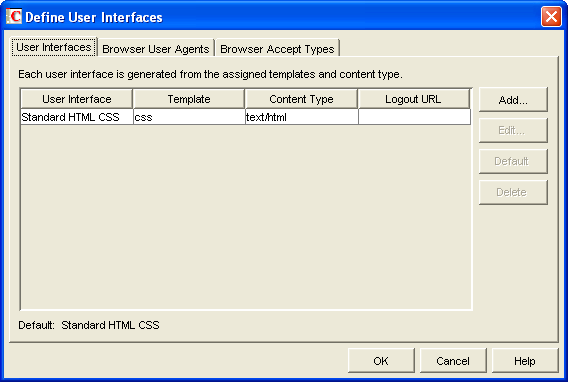
The dialog box includes three tabs:
User Interfaces: The tab lets you add, modify, and remove user interfaces, as well as determine whether or not GroupWise data added to an interface should be cached on proxy servers. Each interface consists of template files that support a specific content type. For example, the predefined Standard HTML interface uses frame-based HTML templates, located in the frames directory, that support the text/html content type.
Browser User Agents: The tab lets you associate a user interface with a Web browser. The association is based on the browser’s User Agent information (signature, platform, version, and so forth).
Browser Accept Types: The tab lets you associate a user interface with a Web browser. The association is based on the content type the browser accepts.
-
To add, remove, or modify user interfaces, click the tab.

The list displays all available user interfaces. The list includes the following information:
User Interface: This column displays the name assigned to the user interface (for example, Standard HTML).
Template: This column displays the directory in which the template files are located. Only the directory name is shown. You can append this directory name to the template path shown on the Templates page to see the full template directory path.
Content Type: This column displays the content type required by the templates (for example, text/html, text/x-hdml, or text/vnd.wap.wml).
Logout URL: By default, when a user logs out, he or she is returned to the standard login page. When adding or editing the user interface, you can use the logout URL to define a different page. If you do so, this column displays the URL. This URL overrides the logout URL specified on the WebPublisher Application object’s Environment page (see Section 54.2, Configuring the WebAccess Application).
Choose from the following options to manage the user interfaces:
Add: Click to add a user interface to the list.
Edit: Select a user interface in the list, then click to edit the interface’s name, template directory, content type, or proxy caching setting.
Default: Select a user interface in the list, then click to make that interface the default interface. The WebPublisher Application uses the default interface only if it can’t determine the appropriate interface based on the browser’s User Agent (WebAccess Application object > ) or the browser’s accepted content types (WebAccess Application object > ).
Delete: Select a user interface in the list, then click to remove the interface. This only removes the entry from the list. It does not delete the template files from the template directory.
-
To associate a user interface with a Web browser based on the browser’s User Agent information, click the tab.
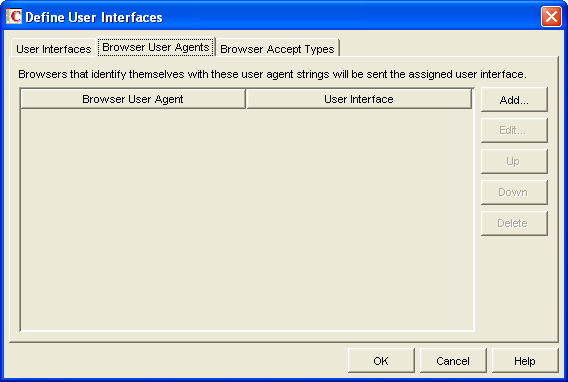
The tab lets you associate a user interface with a Web browser. The association is based on the browser’s User Agent information (signature, platform, version, and so forth). For example, if a browser’s User Agent information includes Windows CE and you have created a specialized Windows CE user interface (templates), you could associate the User Agent and user interface so that Windows CE users see your specialized Windows CE user interface.
If a browser’s User Agent information matches more than one entry in the list, the application uses the first entry. If the browser’s User Agent information does not match any entries in the list, the WebPublisher Application tries to select an interface based on the content types the browser accepts (WebAccess Application object > ). If no match is made based on the Accept Types information, the WebPublisher Application uses the default user interface listed on the User Interfaces tab.
Choose from the following options to manage the associations:
Add: Click to add an entry to the list.
Edit: Select an entry from the list, then click to edit the entry’s information.
Up: Select an entry from the list, then click to move it up in the list. If two entries match the information in a browser’s User Agent header, the WebPublisher Application uses the interface associated with the first entry listed.
Down: Select an entry from the list, then click to move it down in the list.
Delete: Select an entry from the list, then click to remove the entry.
-
To associate a user interface with a Web browser based on the content type that the browser accepts, click the tab.
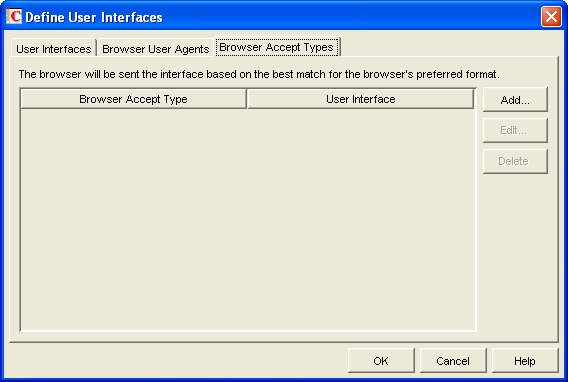
The tab lets you associate a user interface with a Web browser. The association is based on the content type the browser accepts.
Many browsers accept more than one content type (for example, both text/html and text/plain). If the list contains more than one acceptable content type, the WebPublisher Application uses the browser’s preferred content type, which is the type that is listed first in the browser’s Accept Type header.
If no interface can be determined based on the entries in the list, the WebPublisher Application uses the default user interface listed on the User Interfaces tab.
Choose from the following options to manage the associations:
Add: Click to add an entry to the list.
Edit: Select an entry from the list, then click to edit the entry’s information.
Delete: Select an entry from the list, then click to remove the entry.
-
Click to save your changes and return to the WebPublisher Application object’s Templates page.
54.3.4 Controlling Availability of WebPublisher Features
WebPublisher users can:
-
View documents in HTML format.
-
Open documents in native format.
All users who access WebPublisher through a single Web server have the same feature access. You cannot configure individual user settings. However, if you have multiple Web servers, you can establish different settings for the Web servers by completing the following steps for each server’s WebPublisher Application.
To configure the WebPublisher Application’s user settings:
-
In ConsoleOne, right-click the WebAccess Application object, then click .
-
Click to display the Settings page.
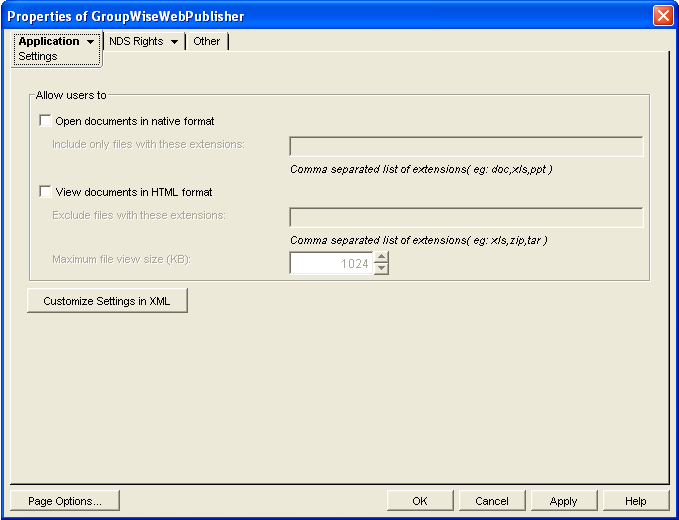
-
Configure the following settings:
Open Documents in Native Format: By default, the option enables user to save library documents to their local drives and then open them in their native applications. You can turn on this option to enable the option. The option enables users to open documents directly in their native applications without first saving the files to the local drive.
This option requires that 1) each user’s Web browser knows the correct application or plug-in to associate with the document, according to its file extension or MIME type, and 2) the application or plug-in is available to the user. Otherwise, the user is prompted to save the file to disk or specify the application to open it.
This option and the t option can both be enabled at the same time. Doing so gives users both the option and the option, which means they have the choice of opening a document in its native application or viewing it as HTML.
-
Include Only Files With These Extensions: If you want only certain file types to be have the option, specify the file types in the field. Include only the extension and separate each extension with a comma (for example, doc, xls, ppt). The Open option is not available for any file types not entered in this field.
View Documents in HTML Format: Enable this option if you want users to be able to view library documents in HTML format. Disable this option to require users to save a document to a local drive and view it in its native application. WebAccess uses Oracle Outside In HTML Export to convert files to HTML format. For a list of the supported file format conversions, see Oracle Outside In Technology Supported Formats.
This option and the option can both be enabled at the same time. Doing so gives users both the option and the option, which means they have the choice of viewing a document as HTML or opening it in its native application.
-
Exclude Files With These Extensions: If you want to exclude certain file types from having the View option, enter the file types in the field. Include only the extension and separate each extension with a comma (for example, doc, xls, ppt). The option is available for any file types not entered in this field.
-
Maximum Document View Size: Specify the maximum size file that can be viewed in HTML format. If a file exceeds the maximum size, it must be opened in native format (if allowed) rather than viewed in HTML format. The default maximum size is 1024 KB.
-
-
Click .